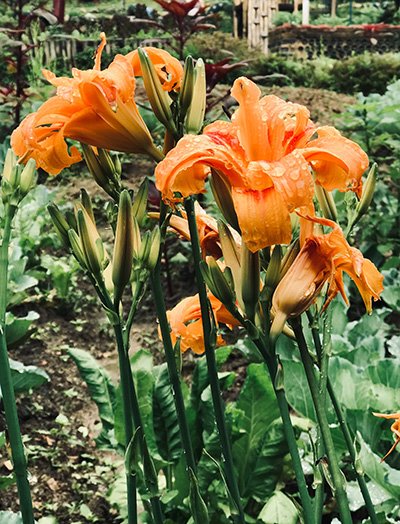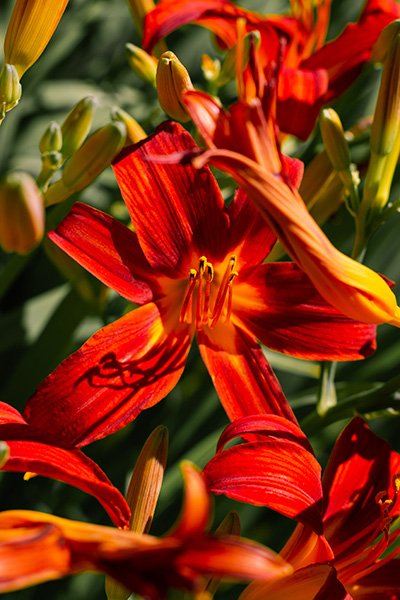You'll find them along roadsides, on hills, or in old gardens! The bright orange flowers of this daylily bring a wild and vibrant appearance to any landscaping and quickly grow to fill in large areas with their color. The orange daylily is simple to care for and able to thrive in conditions where other plants would fail. Keep reading to learn more about this colorful and hardy flower and how to grow it in your garden!
Botanical Name
Common Name
Plant Type
Mature Size
Sun Requirement
Soil Type
Hardiness Zone
Pet Friendly
Hemerocallis fulva
Orange Day-Lily
Perennial
24 - 36 inches tall
Full Sun to Partial Shade
Well-draining soil
USDA Zones 3-9
No
What Is Orange Day-Lily?
There are many types of lilies with orange blooms, but the Orange Daylily (Hemerocallis fulva) is so ubiquitous that it is typically referred to as the "common daylily." Other names include ditch lily, tawny daylily, and tiger daylily. The orange daylily is native to areas of Asia and was brought to North America sometime during the 17th century. Because it thrives in many growing conditions and can quickly displace native plants, it is listed as "invasive" in some states.
The orange daylily is known for its showy flowers. They are a brilliant orange, with long petals that curve back and highlight a vibrantly-colored throat, long stamens, and a single style. The orange petals are often striped with dark red and yellow, which explains the nickname of "tiger daylily". Each brilliant flower lasts only for a day before fading away. However, each flower stalk is so laden with buds that you will enjoy the bright orange show for much of the summer months!
The leaves of Hemerocallis fulva are long, bright green, and strap-like, shooting up and then curving back to the ground. This creates beautiful foliage even outside of the blooming season, and many homeowners will use orange daylilies as a low-maintenance ground cover on hillsides that they would prefer not to mow. Each day, lily spreads through a rhizome root system, as well as frequent self-seeding. This causes orange daylilies to form dense patches.
Daylilies are distinct from true lilies. True to their name, the blooms only last for the span of one day, unlike other types of lilies. Daylilies also spread underground through rhizomes, whereas true lilies have tuberous, fleshy roots. Another difference between a daylily and a true lily is that the flower stalk of daylilies is completely devoid of leaves. The leaves of daylilies grow up separately from the soil.

Image Source: Unsplash
Orange Daylily Care Requirements
Light
Orange Day Lilies are typically recognized as plants that thrive in sunlight. They perform best when they receive full sun to partial shade. Full sun indicates a minimum of 6 hours of direct sunlight daily. In regions with cooler or hotter climates, providing some afternoon shade can help protect the plants from extreme heat.
Orange Day Lilies have the ability to withstand certain levels of shade, especially during the sunniest periods of the day. If you're growing them in a region with intense sunlight, providing them with morning sun and afternoon shade might be beneficial.
Water
New plants will need to be watered regularly in order for the root system to be established. This translates to providing deep watering every week. Ensuring the soil remains adequately moist without becoming waterlogged is crucial. Once the roots get settled (typically after the first year), it is unlikely that you'll ever need to water your daylilies again unless you are in a period of drought. Daylilies are drought-tolerant plants but produce more blooms if they receive an inch of water weekly.
Temperature
Orange Day Lilies can be grown in USDA hardiness zones 3 through 9. This covers a large portion of the United States, indicating their ability to tolerate a broad range of temperatures.
Orange Day Lilies are considered cold, hardy plants. They can withstand frost and even light freezes without significant damage. In fact, exposure to cooler temperatures in the fall can sometimes enhance their flower bud formation for the following season.
While they can handle cooler temperatures, Orange Day Lilies are also quite heat-tolerant. They can thrive in hot summer conditions without wilting or suffering. Nevertheless, in regions with exceptionally high temperatures, offering shade during the day's peak heat can prove advantageous.
Humidity
Orange Day Lilies generally prefer moderate humidity levels. They can tolerate various humidity conditions, but they are well-suited for typical garden or outdoor humidity levels found in most regions.
Soil
Hemerocallis fulva will happily grow in very poor soil conditions - as long as that soil has good drainage! Orange DayLilies require effective drainage and have the capacity to adapt to various soil types. They do not flourish in waterlogged soil, as it can result in root rot. To prevent excess water buildup around the roots, ensure the soil is well-draining.
Orange Day Lilies prefer mildly acidic to neutral soil pH levels, falling within the range of approximately 6.0 to 7.0. This pH range provides a suitable environment for nutrient uptake by the plants.
Fertilization
Orange Day Lilies benefit from fertilization in the early spring, just as new growth emerges. This provides them with an infusion of nutrients that aids in fostering their growth and promoting the production of flowers. Choose a well-balanced, slow-release granular fertilizer with an N-P-K ratio (nitrogen-phosphorus-potassium) of approximately 10-10-10 or similar. This provides a mix of essential nutrients supporting foliage development and flowering.
For those who lean towards organic fertilization, well-aged compost or composted manure can serve as a natural nutrient source. These materials enrich the soil and provide a slow release of nutrients over time.
Orange Daylilies don't require heavy fertilization. Excessive fertilizer application can result in an overgrowth of leaves, often at the expense of flower development. Opting for a more conservative approach with slightly less fertilizer is advisable, as it prevents the risk of over-fertilization.
Propagation
Propagation of Orange Day Lilies (Hemerocallis fulva) can be accomplished through various techniques, encompassing division, seed propagation, and bulb offsets. Here's how you can propagate them:
Division
- The most common and successful method of propagating Orange DayLilies is through division. This requires the separation of plant clumps into smaller segments, each possessing its own root system and shoots.
- Select a fully mature Orange Day Lily plant that has been established in the soil for several years. Optimal division should be carried out during the early spring or fall seasons.
- Using a garden fork, carefully unearth the entire cluster of Orange Day Lilies, taking care to avoid harming the root system.
- Gently separate the clump into smaller sections by pulling the plant apart or using a clean, sharp knife.
- Each divided section should have a healthy set of roots and several shoots or fans.
- Replant the divided sections at the original depth where they were initially growing, ensuring appropriate spacing as required. Thoroughly water the newly planted divisions after planting.
Bulb Offsets
- As Orange Day Lilies grow, they produce bulb offsets around the base of the main plant. These bulb offsets can be detached and subsequently planted to establish new plants.
- Wait until the bulb offsets have reached a sufficient size, possessing their own roots and shoots, before separating. This usually happens in spring or early fall.
- Gently dig up the main plant and the attached offsets.
- Gently detach the bulb offsets from the main plant using either your hands or a sanitized knife.
- Replant the offsets at the same depth they were originally growing, making sure to water them in well.
Seed Propagation
- While Orange Day Lilies can be grown from seeds, this method is less commonly used because they may not come true to the parent plant's characteristics.
- Collect ripe seed pods from the plant after the flowers have faded. Allow the seed pods to naturally dry and open on their own.
- Collect the seeds and plant them in well-prepared soil either in late fall or early spring. Press the seeds gently into the soil without completely covering them.
- Maintain the soil consistently moist, avoiding waterlogging until the seeds initiate germination.
- Transfer the young seedlings to their permanent positions once they have grown to a manageable size.

Image Source: Unsplash
Common Problems With Growing Orange Daylily
Pests
Aphids, small insects that cluster on leaves and stems, can lead to distortion and yellowing. Combat them with a strong stream of water or insecticidal soap. Spider mites, tiny pests causing stippling and webbing, can be managed by regularly hosing down plants and introducing natural predators like ladybugs. All of these insects can be treated by removing as many adults as possible using a strong spray of water and then treating the plant with neem oil or insecticidal soap.
Slugs and snails may chew holes in leaves, so hand-picking them during the evenings or using barriers like crushed eggshells can be effective.
Common Diseases
Hemerocallis rust, a fungal disease marked by orange, yellow, or rusty spots on leaves, can be controlled by removing and destroying infected foliage, as well as ensuring good air circulation. To prevent crown rot resulting from excessively moist soil, enhance drainage and refrain from overwatering.
Foliage Problems
Yellowing leaves stemming from issues like nutrient deficiencies, overwatering, or poor drainage can be addressed by adjusting watering practices and offering balanced fertilizer. Brown leaf tips, often caused by underwatering or soil salt buildup, can be mitigated by providing adequate water and leaching the soil to flush out excess salts.
Non-Flowering
Insufficient sunlight can lead to fewer or no blooms, so make sure your plants receive at least six hours of direct sunlight daily. Overcrowding can also hinder flowering, prompting the need to divide and space plants correctly for optimal blooming.
Winter Damage
In colder climates with challenging winter conditions, apply mulch around the plant base during fall to safeguard the roots and crowns from potential damage.
Is Orange Daylily Pet Friendly?
Orange Day Lilies (Hemerocallis fulva) are not considered safe for pets, particularly cats. All parts of the plant, including the leaves, stems, flowers, and roots, contain compounds that can be toxic if ingested. These compounds can lead to gastrointestinal distress, vomiting, diarrhea, and other unfavorable responses in cats and other animals.
If you have pets, especially cats, it's recommended to avoid planting Orange Day Lilies in areas where they have access. Instead, opt for pet-safe plants that won't pose a risk to your furry friends. Always make sure to research the safety of plants before introducing them to your home or garden, especially if you have pets that might be curious and prone to nibbling on plants.
